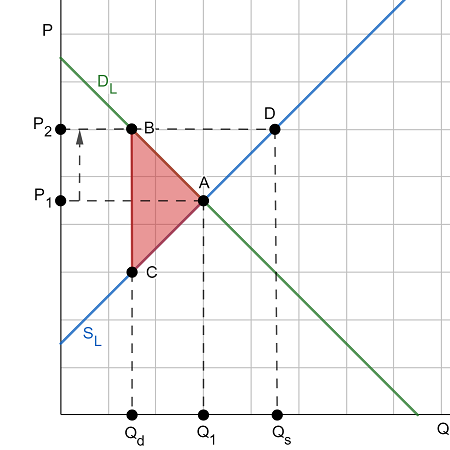Deadweight loss is just one of the costs and benefits of government intervention although often used as an argument against government intervention in the economy.
By understanding the deadweight loss from government intervention, policymakers can design interventions that minimize the costs and maximize the benefits. This article explains the economic term Deadweight loss and provides practical examples of how to calculate dwl.
Table of contents
- What is deadweight loss in Economics?
- How to calculate deadweight loss Dwl Economics
- How to calculate DWL from tax
- How to calculate DWL from a graph
- Practical Example Of How to Calculate Deadweight Loss
- What government interventions have led to significant deadweight loss?
- Frequently Asked Questions
- Conclusion
- References
- Recommendations
What is deadweight loss in Economics?
Deadweight loss in economics is the cost to society of producing less of a good or service than is socially optimal. It is the economic inefficiency that occurs when the government intervenes in a market, such as by imposing a tax or setting a price ceiling or price floor.
This intervention causes the market to produce less output than it would under free market conditions, and it also leads to a higher price for consumers. The deadweight loss is the difference between the consumer surplus and producer surplus that is lost due to government intervention.
Deadweight loss is a cost to society because it represents a loss of resources that could have been used to produce other goods and services.
Read Also: How Much Does a Hot Air Balloon Cost? Is It Worth It?
How to calculate deadweight loss Dwl Economics
To calculate deadweight loss, you can use the following formula:
Deadweight loss = 1/2 * (P2 - P1) * (Q1 - Q2)
where:
- P1 is the equilibrium price before the government intervention
- P2 is the price after the government intervention
- Q1 is the equilibrium quantity before the government intervention
- Q2 is the quantity after the government intervention
For example, suppose the government imposes a $1 tax per gallon of gasoline. This will cause the price of gasoline to rise from $2 to $3 per gallon. As a result, consumers will demand less gasoline and producers will supply less gasoline.
The deadweight loss from this tax can be calculated as follows:
Deadweight loss = 1/2 * ($3 - $2) * (Q1 - Q2)
If the quantity demanded of gasoline falls from 100 million gallons to 90 million gallons after the tax is imposed, then the deadweight loss is:
Deadweight loss = 1/2 * ($1) * (100 million gallons - 90 million gallons) = $5 millionRead Also: 37 Passive Income Ideas You Should Know
How to calculate DWL from tax
To calculate the deadweight loss (DWL) from a tax, you can use the following formula:
DWL = 1/2 * (P2 - P1) * (Q1 - Q2)where:
- P1 is the equilibrium price before the tax
- P2 is the equilibrium price after the tax
- Q1 is the equilibrium quantity before the tax
- Q2 is the equilibrium quantity after the tax
The following steps describe how to calculate DWL from tax:
- Determine the equilibrium price and quantity before the tax. This can be done by analyzing the supply and demand curves for the good or service.
- Determine the equilibrium price and quantity after the tax. This can be done by shifting the supply curve by the tax amount.
- Calculate the DWL. This can be done by plugging the equilibrium prices and quantities into the DWL formula above.
Read Also: How Do I Get Bachelor’s Degree in Graphic Design?
How to calculate DWL from a graph
To calculate deadweight loss (DWL) from a graph, you can use the following steps:
- Identify the equilibrium price and quantity before the government intervention. This is the point where the supply and demand curves intersect.
- Identify the equilibrium price and quantity after the government intervention. This will be a different point on the graph, depending on the type of intervention.
- Draw a triangle between the two equilibrium points and the new supply or demand curve. This triangle represents the DWL.
- Calculate the area of the triangle. This can be done using the following formula:
Area of a triangle = 1/2 * base * height
The base of the triangle is the difference between the two equilibrium quantities. The height of the triangle is the difference between the two equilibrium prices.
For example, suppose the government imposes a tax on a good. This will shift the supply curve up, which will lead to a new equilibrium price and quantity. The DWL from the tax is represented by the triangle between the two equilibrium points and the new supply curve.
In the diagram, the equilibrium price before the tax is P1 and the equilibrium quantity is Q1. After the tax, the equilibrium price rises to P2 and the equilibrium quantity falls to Q2. The DWL is represented by the triangle ABC.
To calculate the area of the triangle ABC, we can use the following formula:
Area of triangle ABC = 1/2 * (Q2 - Q1) * (P2 - P1)Read Also: How to Write Entry-Level Marketing Cover Letter| Writing Tips and Examples
Practical Example Of How to Calculate Deadweight Loss
Let’s say there is only one company that produces a certain type of medicine, let’s say Medicine A. This company has a monopoly on medicine, and it charges a very high price for it. This high price leads to a deadweight loss because some people who need the medicine are unable to afford it.
Now, imagine that a new company develops a generic version of Medicine A. This generic version is just as effective as the original medicine, but it is much cheaper. As a result, many people who were previously unable to afford Medicine A are now able to afford the generic version.
The generic version of Medicine A leads to a decrease in deadweight loss. However, it also leads to some deadweight loss of its own. This is because the new company may not be able to produce as much of the medicine as the original company.
To calculate the deadweight loss from the monopoly price of Medicine A, we can use the following formula:
Deadweight loss = 1/2 * (P2 - P1) * (Q1 - Q2)
where:
- P1 is the equilibrium price before the monopoly
- P2 is the monopoly price
- Q1 is the equilibrium quantity before the monopoly
- Q2 is the quantity sold at the monopoly price
For example, suppose the equilibrium price of Medicine A before the monopoly was $10 per bottle, and the equilibrium quantity was 100,000 bottles. Suppose that the monopoly price is $20 per bottle, and the quantity sold at the monopoly price is 50,000 bottles.
The deadweight loss from the monopoly price of Medicine A would be calculated as follows:
Deadweight loss = 1/2 * ($20 per bottle – $10 per bottle) * (100,000 bottles – 50,000 bottles) = $125,000
This means that the monopoly price of Medicine A is causing a deadweight loss of $125,000.
What government interventions have led to significant deadweight loss?
Some government interventions that have led to significant deadweight loss include:
- Agricultural subsidies: Agricultural subsidies are payments made by the government to farmers to support their production. These subsidies can lead to deadweight loss by encouraging farmers to produce more than they would under free market conditions. This can lead to lower prices for consumers, but it can also lead to overproduction and waste.
- Price controls: Price controls are laws that set the maximum or minimum price that can be charged for a good or service. Price ceilings, which set a maximum price, can lead to deadweight loss by creating shortages. Price floors, which set a minimum price, can lead to deadweight loss by creating surpluses.
- Tariffs and quotas: Tariffs and quotas are restrictions on international trade. Tariffs are taxes on imported goods, while quotas are limits on the quantity of imported goods. Tariffs and quotas can lead to deadweight loss by reducing the efficiency of the global economy.
- Occupational licensing: Occupational licensing is a system that requires workers to obtain a license from the government in order to work in a particular field. Occupational licensing can lead to deadweight loss by restricting the supply of workers and increasing the cost of goods and services.
- Minimum wage: The minimum wage is the lowest wage that employers are legally allowed to pay their workers. The minimum wage can lead to deadweight loss by reducing the demand for workers and increasing unemployment.
Frequently Asked Questions
Welfare loss is a broader term that encompasses all of the costs associated with government intervention, including the deadweight loss
The government can reduce deadweight loss by designing its interventions more carefully. For example, the government can use taxes with a lower marginal tax rate, or it can use subsidies instead of taxes.
Deadweight loss can lead to a number of economic consequences, including:
Reduced economic growth
Lower living standards
Higher unemployment
Reduced consumer choice
Some of the benefits of government intervention, even if it leads to deadweight loss, include:
Correcting market failures
Redistributing income
Promoting social welfare
While deadweight loss is often associated with economic inefficiency, it doesn’t necessarily mean a monetary loss. It can also refer to lost opportunities and unexploited gains.
Conclusion
By understanding the deadweight loss from government intervention, policymakers can design interventions that minimize the costs and maximize the benefits. Calculating deadweight loss provides valuable insights into market efficiency. Read through this piece on how to calculate deadweight loss now.
References
- Masterclass.com – Deadweight Loss Guide: 7 Causes of Deadweight Loss
- Corporatefinanceinstitute.com – Deadweight Loss
- WallStreetmojo.com – What is the Deadweight Loss Formula?






